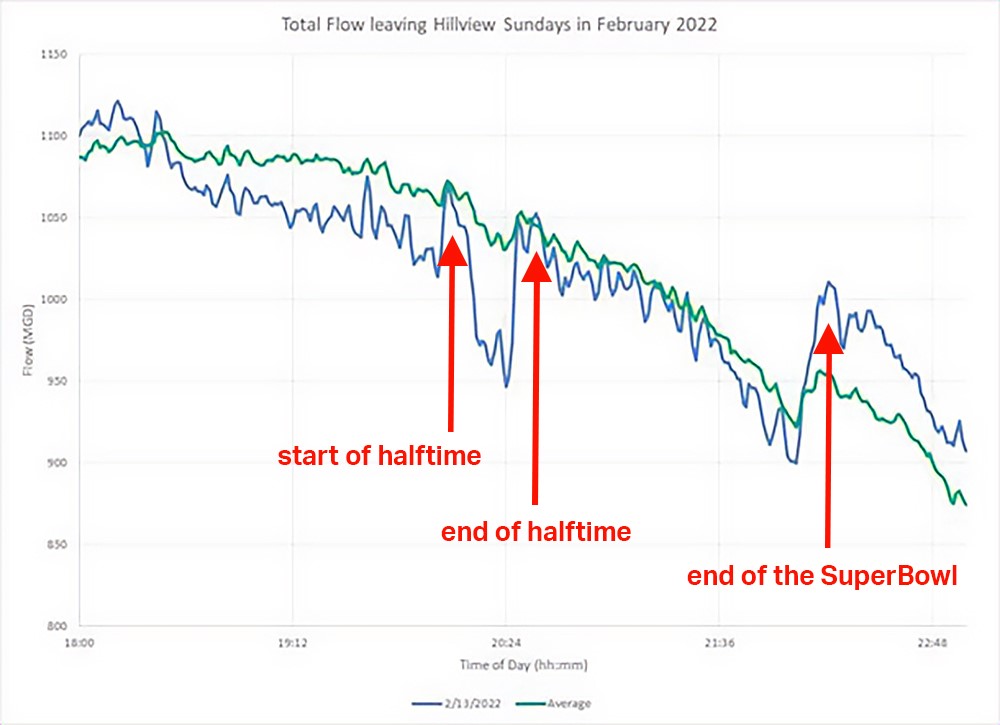DEP Ready to Tackle the Super Bowl Super Flush
February 7, 2025
With the Super Bowl set to dominate screens this Sunday, water supply operators with the New York City Department of Environmental Protection (DEP) are gearing up for their own version of game day—one where the water supply system is the real MVP. It’s a synchronized flushing phenomenon worthy of its own play-by-play analysis.
Every year, DEP sees a dramatic surge in water usage at three key moments during the biggest TV and sporting event of the year. This drastic uptick coincides with:
- the start of the halftime show,
- the end of the halftime show,
- and the end of the game.
For example, last year, DEP saw a jump in water usage after the second quarter ended and musicians Usher and Alicia Keys began warming up for the halftime show. But, when the game entered overtime, there was a significant drop in water demand as Kansas City and San Francisco battled it out in a close nailbiter. Then, once the final whistle blew, the water flow surged again with a post-game spike equivalent to 467,881 additional toilet flushes.
Now, that’s a super flush!
(Just for reference, on a normal Sunday, the demand for water follows the typical daily patterns of the City—as night falls and more people go to sleep, the demand for water steadily goes down. That pattern continues until people begin waking up, showering, brushing their teeth, making their coffee, and preparing for the day ahead.)
This increase in water demand during the Super Bowl directly correlates to the public’s TV viewing habits for the big game. Audiences are glued to their chairs during the plays, commercials, and halftime show. That means they are also rushing to use water—and, yes, flush the toilet — during those few key breaks in between and after the game.
DEP water supply operators have been watching and monitoring this trend for decades and are well prepared for it.
In the hours before the Super Bowl begins, DEP water supply operators will send some extra water down to Hillview Reservoir, which sits on the border of the Bronx and Yonkers, to account for the spikes in demand throughout the night.
The volume of water stored in Hillview Reservoir is closely tied to the water pressure throughout New York City’s distribution system —so keeping the reservoir full and accounting for the extra demand ensures that none of our customers notice a drop in water pressure.
It’s all part of running the biggest municipal water supply in the United States—whether our teams are in the big game or not.
About the NYC Department of Environmental Protection
DEP manages New York City’s water supply, providing more than 1 billion gallons of high-quality drinking water each day to nearly 10 million residents, including 8.8 million in New York City and 1 million more in counties north of the City. The water is delivered from a watershed that extends more than 125 miles from the City, comprising 19 reservoirs and three controlled lakes. Approximately 7,000 miles of water mains, tunnels and aqueducts bring water to homes and businesses throughout the five boroughs, and 7,500 miles of sewer lines and 96 pump stations take wastewater to 14 in-city treatment plants. DEP also protects the health and safety of New Yorkers by enforcing the Air and Noise Codes and asbestos rules. DEP has a robust capital program, with a planned $33.3 billion in investments over the next 10 years. For more information, visit nyc.gov/dep, like us on Facebook, or follow us on X, formerly known as Twitter.





